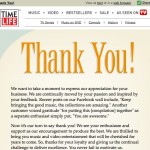An easy client is one who just wants to make money: as long as you are successful in helping them reach their goal, all is good. But more typically, you’ll be dealing with an organization that has layers of command and that means client politics to be navigated. Here are two of the most typical organizational dynamics and how I’ve learned to deal with them.
Managers vs. Directors. A director is a person with profit & loss responsibility—that easy client I mentioned who just wants to make money. However, you’re unlikely to have direct access to a director level, especially early in the relationship, and even if you do they won’t focus on the details of individual projects. Instead you will report to some form of marketing manager—a person who is tasked with meeting deadlines, staying on budget, and especially presenting no negative surprises to upper management.
Your challenge in dealing with the manager is that your concept and your very existence are inherently risky—you represent the new and unknown, otherwise why would they bring you in to replace whatever else they were using? Your job is to convince the manager that this journey into uncharted waters will be safe and secure as a Caribbean cruise (and without the Legionnaire’s Disease).
You can sell yourself and your concept as a safe solution with a/case histories—other marketers (in recognizable or peer organizations) have done exactly the same thing successfully; b/testimonials—references from clients in those companies they can talk to; c/your personal presentation—this is the time to be buttoned up and professional, not edgy; d/a gentle reminder that one of the possible negatives is being left behind—because others aren’t afraid to innovate and they, the client, are.
Every outside contractor has had the frustration of dealing with managers who seem more focused on budgets and schedules than actual results, but keep in mind that’s what they are getting their job performance reviewed on. Be patient and reasonable, and be prepared to stop seeking work from managers whose near-term focus keeps you from doing the work you want to do or can afford to do.
One last thing: never give a manager a negative surprise. After what I’ve said above you can guess why this is. A blown deadline or budget, or work that doesn’t follow the creative brief, is going to make this person crazy and you may never get work from them (or anyone else in their company) again.
Sound like a lot to deal with? Remember that good managers are where future directors come from. Be patient, prove your reliability, and you may be surprised at how the relationship blossoms once you earn their trust.
Sales vs. Marketing. If the business model is to generate leads, then your company has both a sales and a marketing VP and the sales VP is the one with the big swinging appendage. Because, as sales trainer Roy Chitwood says, “nothing happens until somebody sells something.” The sales department is who brings in the revenues without which nobody would have a job. Right?
Your problem is that your client is the marketing department, which is either subordinate to sales or actually reports to it. And you know, as does the sales VP when he or she is alone at night, that the quality of leads generated by the marketing department is the engine that drives the sales organization. Actually, I take that back, sales is not at all shy about crediting the importance of leads but in a backhanded manner. If they can’t make the sale, then it’s because the leads aren’t good enough.
You can be part of your marketing client’s survival plan by making sure the leads ARE good. You do this by writing your copy as the first step of the sales process and providing good information and sound reasons to want to find out more. Salespeople may still complain (because not making the sale is never their fault) but the better quality of leads will shine through on the bottom line.
A special sales/marketing problem comes up when you want to use an offer such as a freebie or entry in a drawing to boost response. Sales will complain the leads are no good because you bribed people to respond. The only way to resolve this objection is to set up a test. Have a lower-level support person field the registrations and, if it’s obvious the prospect responded only to get the freebie, don’t pass that lead onto sales. Then see if you have more qualified leads at the end of the day.
I once participated in exactly this test with an enterprise software company. By offering an entry to win a cool tech gadget, we boosted registrations by 24%. Of these, 10% were quickly dismissed as freebie-seeking lookie-loos. But that left the client with a 14% increase in qualified leads with basically no increase in cost.
I feel like I’ve been unusually snarky in this post. I have generally had cordial, even friendly relationships with my clients and above I’m describing worst case scenarios. But the corporate marketing world is not a relaxing or non-competitive space. You need to be careful out there.

